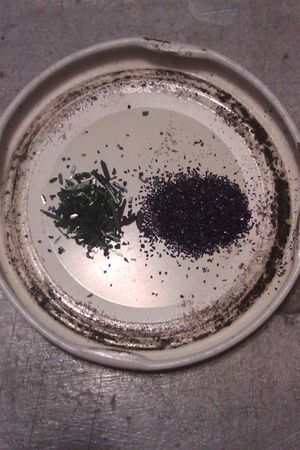Difference between revisions of "Potassium permanganate"
(→Handling) |
|||
| Line 1: | Line 1: | ||
| − | + | [[File:Kmno4.jpg|thumb|Potassium permanganate crystals of different sizes.]] | |
| − | + | ||
Potassium permanganate from pharmacy.JPG|KMnO4 from a Polish pharmacy | Potassium permanganate from pharmacy.JPG|KMnO4 from a Polish pharmacy | ||
KMnO3 Pills.JPG|KMnO4 Pills | KMnO3 Pills.JPG|KMnO4 Pills | ||
Revision as of 12:01, 25 January 2016
Potassium permanganate from pharmacy.JPG|KMnO4 from a Polish pharmacy KMnO3 Pills.JPG|KMnO4 Pills </gallery> Potassium permanganate is an ionic compound with the formula KMnO4. At room temperature and pressure it is a deep violet crystalline salt that dissolves to form an intense violet or magenta solution, often tending to black in high concentrations. Potassium permanganate contains manganese in the +7 oxidation state, and is a strong oxidizer commonly encountered in a lab setting. It participates in a wide range of reactions, from simple colour change demonstrations to complex organic syntheses.
Contents
Properties
Physical
Potassium permanganate is a dark purple, almost black, crystalline solid that is soluble in water to form an intense magenta solution.
Chemical
When exposed to light, potassium permanganate will photodecompose to form potassium manganate and manganese dioxide.
Concentrated sulfuric acid dehydrates potassium permanganate to the incredibly unstable manganese heptoxide. Adding a few drops of glycerol (glycerin) to potassium permanganate creates an intense flame hot enough to light thermite and pyrotechnics. Addition of a dilute solution of sodium hydroxide and sucrose to potassium manganate solution and hydrous manganese dioxide creates a "chemical chameleon" reaction, in which the permanganate ion is slowly reduced several times, producing several vivid color changes.
In acidic solutions, permanganates reduce to manganese(II) ions. In neutral and mildly basic solutions, it reduces to manganese dioxide. In extremely basic solutions, the bluish-green manganate ion would form, but it would exist only transiently as it would be reduced to manganese dioxide.
Availability
Like many chemicals, potassium permanganate was easier to find a few years ago, moderately difficult to find today and most likely getting harder and harder to locate in the next few years. It is sometimes sold as a camping chemical because it can light hot fires (when combined with glycerin), decontaminate water and disinfect wounds. Today it is easiest to find potassium permanganate at pharmacies/chemists or in aquarium supply stores as a type of water treatment.
Legality
The sale of potassium permanganate is regulated in several countries, due to its use in cocaine purification and methcathinone production. Check the local laws before using this substance.
Preparation
Making permanganate is a difficult and messy exercise, and although extensive discussion on this topic has been undertaken on Sciencemadness, a method that is accessible to the amateur but also produces worthwhile yields is still yet to be found.
The most popular method involves fusing a mixture of potassium nitrate, potassium hydroxide and manganese dioxide to form crude potassium manganate, then oxidizing it with the addition of a dilute solution of sodium bicarbonate (baking soda).
Handling
Safety
While not overly toxic, potassium permanganate may strongly stain skin or other materials due to the formation of manganese dioxide when reacted with certain organics.
Contact with concentrated sulphuric acid will create a very powerful, unpredictable and unstable oxidizer manganese heptoxide. Accidental creation of this must be avoided, and has been known to create disaster for the backyard chemist.
Potassium permanganate vigorously reacts with many organic compounds, such as glycerol and ethylene glycol, causing some to spontaneously combust. Appropriate care must be taken when combining the two in any setting.
Storage
Potassium permanganate should be stored in closed bottles, away from any acidic vapors or volatile organic compounds. KMnO4 solutions should be covered as they will slowly break down in open air, due to dust or other chemical vapors.
Disposal
Potassium permanganate can be neutralized with hydrogen peroxide, resulting potassium hydroxide and manganese dioxide.
